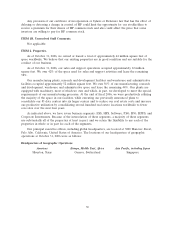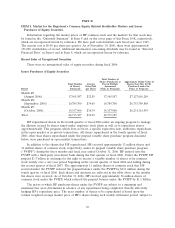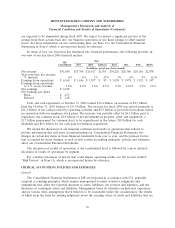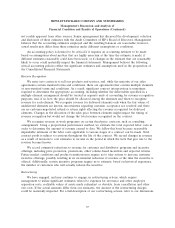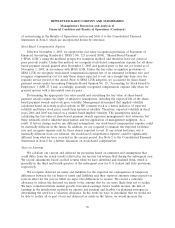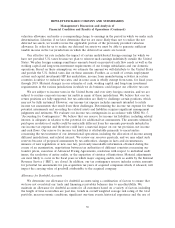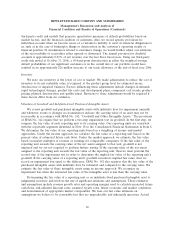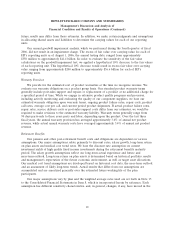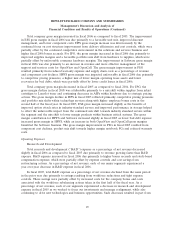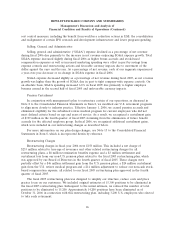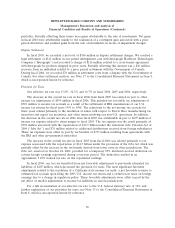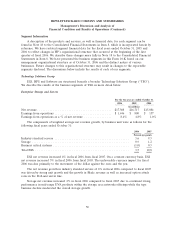HP 2006 Annual Report Download - page 44
Download and view the complete annual report
Please find page 44 of the 2006 HP annual report below. You can navigate through the pages in the report by either clicking on the pages listed below, or by using the keyword search tool below to find specific information within the annual report.HEWLETT-PACKARD COMPANY AND SUBSIDIARIES
Management’s Discussion and Analysis of
Financial Condition and Results of Operations (Continued)
third-party credit risk models that generate quantitative measures of default probabilities based on
market factors, and the financial condition of customers. Also, we record specific provisions for
individual accounts when we become aware of a customer’s inability to meet its financial obligations to
us, such as in the case of bankruptcy filings or deterioration in the customer’s operating results or
financial position. If circumstances related to customers change, we would further adjust our estimates
of the recoverability of receivables either upward or downward. The annual provision for doubtful
accounts is approximately 0.03% of net revenue over the last three fiscal years. Using our third-party
credit risk model at October 31, 2006, a 50-basis-point deterioration in either the weighted average
default probabilities of our significant customers or in the overall mix of our portfolio would have
resulted in an approximately $26 million increase to our trade allowance at the end of fiscal year 2006.
Inventory
We state our inventory at the lower of cost or market. We make adjustments to reduce the cost of
inventory to its net realizable value, if required, at the product group level for estimated excess,
obsolescence or impaired balances. Factors influencing these adjustments include changes in demand,
rapid technological changes, product life cycle and development plans, component cost trends, product
pricing, physical deterioration and quality issues. Revisions to these adjustments would be required if
these factors differ from our estimates.
Valuation of Goodwill and Indefinite-Lived Purchased Intangible Assets
We review goodwill and purchased intangible assets with indefinite lives for impairment annually
and whenever events or changes in circumstances indicate the carrying value of an asset may not be
recoverable in accordance with SFAS No. 142, ‘‘Goodwill and Other Intangible Assets.’’ The provisions
of SFAS No. 142 require that we perform a two-step impairment test on goodwill. In the first step, we
compare the fair value of each reporting unit to its carrying value. Our reporting units are consistent
with the reportable segments identified in Note 18 to the Consolidated Financial Statements in Item 8.
We determine the fair value of our reporting units based on a weighting of income and market
approaches. Under the income approach, we calculate the fair value of a reporting unit based on the
present value of estimated future cash flows. Under the market approach, we estimate the fair value
based on market multiples of revenue or earnings for comparable companies. If the fair value of the
reporting unit exceeds the carrying value of the net assets assigned to that unit, goodwill is not
impaired and we are not required to perform further testing. If the carrying value of the net assets
assigned to the reporting unit exceeds the fair value of the reporting unit, then we must perform the
second step of the impairment test in order to determine the implied fair value of the reporting unit’s
goodwill. If the carrying value of a reporting unit’s goodwill exceeds its implied fair value, then we
record an impairment loss equal to the difference. SFAS No. 142 also requires that the fair value of the
purchased intangible assets with indefinite lives be estimated and compared to the carrying value. We
estimate the fair value of these intangible assets using an income approach. We recognize an
impairment loss when the estimated fair value of the intangible asset is less than the carrying value.
Determining the fair value of a reporting unit or an indefinite-lived purchased intangible asset is
judgmental in nature and involves the use of significant estimates and assumptions. These estimates
and assumptions include revenue growth rates and operating margins used to calculate projected future
cash flows, risk-adjusted discount rates, assumed royalty rates, future economic and market conditions
and determination of appropriate market comparables. We base our fair value estimates on
assumptions we believe to be reasonable but that are unpredictable and inherently uncertain. Actual
40


